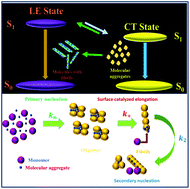Sensing and modulation of amyloid fibrils by photo-switchable organic dots†
Abstract
Abnormal aggregation of amyloidogenic proteins (like Aβ 42, amylin, α-synuclein, insulin) and the deposition of these aggregates is believed to be associated with several diseases known as amyloidosis. The pathway of aggregation involves three distinct phases: the oligomeric, elongation and plateau phases. Among them, the oligomeric phase of Aβ 42 and α-synuclein involves the generation of transient oligomeric species suspected to cause several neurological disorders, including Alzheimer’s and Parkinson’s diseases. Over the past few years, scientists have devoted much more effort to devising new fluorescent molecular probes to estimate the mechanisms of formation, and have gained vital information about possible therapeutic routes for amyloidosis. However, such fluorescent probes face serious limitations because of self-quenching at high concentrations of the probe; therefore, they are inappropriate for quantitative analysis and bio-imaging experiments. Hence, smart biocompatible fluorescent probes are indispensable, as they not only overcome the drawbacks of conventional fluorescent probes, but also have the potential ability to fight amyloidosis through modulation of the pathways involved. In this work, for the first time we introduce a series of promising photo-switchable aggregation-induced emission (AIE) dots (DPAPMI, CPMI) and aggregation caused quenching (ACQ) dots (DMAPMI) which can detect amyloid fibrils in terms of switching and enhancing their fluorescence emission. Interestingly, the organic dots enhance the aggregation rate of insulin by speeding up the microscopic processes, specifically secondary nucleation (with rate constant k2) and the elongation process (with rate constant k+). Moreover, the comparison of kinetics studies with ThT suggests that our organic dots can sense pre-fibrillar aggregates of insulin during the aggregation process, which may be beneficial for the early detection of amyloid fibrils. In summary, our study indicates that these organic dots can be used for the imaging and early stage detection of amyloid fibril formation and the modulation of amyloid formation pathways.



 Please wait while we load your content...
Please wait while we load your content...